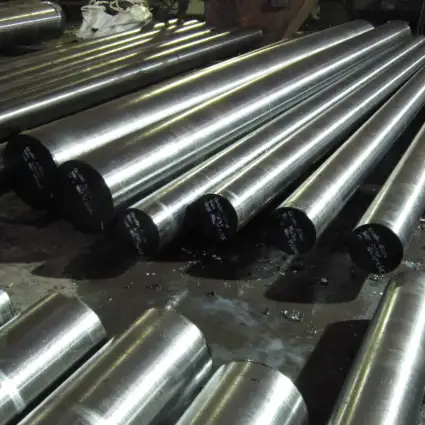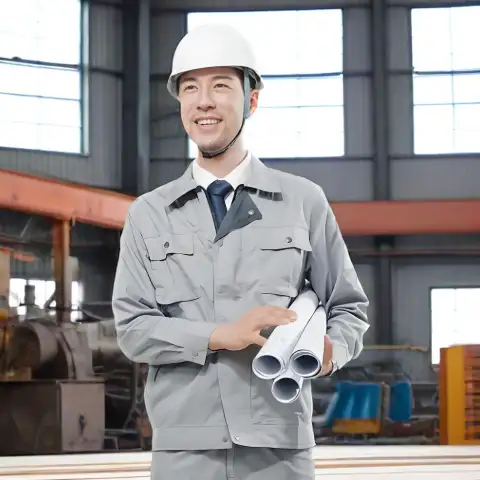“RHC 30–35” denotes a hardness range on the Rockwell C scale (HRC = 30–35) — it is a measured property, not a single alloy or specification. The practical “equivalents” are steels and heat-treatment conditions that produce that hardness (for example, AISI/SAE 4340, EN24 / 36CrNiMo4, and properly tempered 4140/4142 are commonly supplied or processed to ~HRC 30–35 for shafts, gears, and structural components).
What “RHC 30–35” actually means
The string “RHC 30–35” is shorthand for a range on the Rockwell C hardness scale (commonly written HRC 30–35 or 30–35 HRC). It communicates an acceptable hardness window, usually after heat treatment or tempering, and is used in purchase/specification documents to control material properties. Because HRC is a property, many different alloys and heat-treatment states can meet the same HRC window; that is why “equivalent” must be interpreted as different steels or heat-treatments that produce the same hardness and mechanical envelope, not a single exact alloy name.
Hardness scales and numeric equivalents
Engineers often need conversions between hardness systems. Conversions are approximate and depend on microstructure and testing method, but the following table gives widely used equivalences for HRC 30–35.
| Rockwell C (HRC) | Approx. Brinell (HB) | Approx. Vickers (HV) | Typical tensile strength (approx.) |
|---|---|---|---|
| 30 HRC | ~286 HB | ~302 HV | ~850–900 MPa |
| 31 HRC | ~294 HB | ~310 HV | ~880–940 MPa |
| 32 HRC | ~301 HB | ~318 HV | ~900–970 MPa |
| 33 HRC | ~311 HB | ~327 HV | ~930–1000 MPa |
| 34 HRC | ~319 HB | ~336 HV | ~960–1030 MPa |
| 35 HRC | ~327 HB | ~345 HV | ~990–1060 MPa |
Notes:
Conversion charts are empirical and vary by source; the table above is an engineering approximation to be used for specification/back-of-the-envelope checks only. Use direct testing for final acceptance.
Common steel grades that are “equivalent” in practice
Because HRC 30–35 is a property, many common structural and alloy steels can be supplied or processed to this hardness. The table below summarizes practical choices, equivalents (EN/UNS/AISI), and typical uses.
| Common name / designation | Equivalent standards / codes | Typical condition for HRC 30–35 | Typical uses |
|---|---|---|---|
| 4340 (AISI/SAE 4340) | UNS G43400, EN36/36CrNiMo4 (similar) | Quench & temper to HRC 28–36 (common shop delivery 30–35) | Landing gear, shafts, structural high-strength components. |
| 4140 / 4142 | AISI 4140 (EN 42CrMo4 comparable) | Oil / gas quenched and tempered to ~HRC 27–34 depending on section | Gears, pins, shafts where moderate toughness is required |
| EN24 / 36CrNiMo4 | EN36 (UK EN24 historically) | Heat treated for toughness; commonly delivered to HRC ~30–34 | Aerospace/automotive critical forgings |
| 52100 (bearing steel) | SAE 52100 | Can be hardened to higher HRC; tempered to 30–35 for bearing races in some cases | Bearings, races (careful: microstructure is different, limited weldability) |
| Maraging steels (e.g., C300 family) | AMS 6514/AMS 6515 (maraging) | Often aged to give ~RC 30–35 for very high toughness + strength balance | Aerospace tooling, structural high-strength parts (different chemistry and processing) |
Practical point: AISI/SAE 4340 is one of the most commonly specified alloys when buyers ask for “4340 RHC 30–35” because it can reliably be heat-treated to that window even in large sections.

How manufacturers reach HRC 30–35 (heat treatment & processes)
Producing HRC 30–35 depends on alloy composition, part size (section thickness), and process control:
-
Through-hardening alloys (e.g., 4140, 4340)
-
Normal route: austenitize → quench (oil or agitated salt) → temper.
-
Tempering temperature range for HRC 30–35 typically falls into intermediate temper windows (e.g., tempering between ~500–600 °C depending on alloy and target hardness). Exact temperatures vary with desired combination of toughness and strength.
-
-
Case hardening vs through-hardening
-
Case-hardening (carburize / carbonitriding) produces a hard surface case while core remains tougher (core may be ~HRC 30–35 while case is much harder). Specify surface hardness and case depth separately when needed.
-
-
Maraging and age-hardening alloys
-
These use solution treat + age to generate strength without high carbon martensite; target RC 30–35 is achieved by adjusting aging time/temperature and yields exceptional toughness for that hardness bracket.
-
-
Process control and QC
-
Achieving consistent HRC 30–35 across lot and geometry requires calibrated furnaces, controlled quench media, and verification samples. For critical components, manufacturers usually supply hardness maps (multiple readings) and heat-treatment records.
-
Testing, calibration, and acceptance criteria
Rockwell C testing follows standardized methods (ASTM E18 / ISO 6508). Key quality rules:
-
Use properly calibrated Rockwell machines and certified test blocks (NIST traceable blocks or equivalent) to verify machine accuracy.
-
For acceptance specify sample locations and number of indentations per clause (e.g., within ±2 HRC tolerance across specified locations) and whether readings are to be taken on finished surfaces or on test coupons.
-
Where surface condition affects reading (roughness, shot peen, decarburisation), additional polishing or specimen preparation may be required.
Design and application implications at HRC 30–35
-
Wear resistance: HRC 30–35 gives moderate wear resistance suitable for medium-duty gears, shafts, and mechanical fasteners.
-
Toughness: As hardness climbs, toughness declines — HRC 30–35 is often chosen to balance wear and fracture toughness in dynamic components.
-
Fatigue life: Fatigue performance is a combined function of microstructure, hardness, residual stresses, surface finish, and shot peening. For rotating shafts, HRC 30–35 in 4340 is a common compromise.
Machining, welding, and finishing considerations
-
Machining: HRC 30–35 materials are harder than annealed steels — use appropriate tooling grade, slower feed/speed, and coolants. Pre-hardening vs post-hardening machining decision affects cost and distortion.
-
Welding: Many alloy steels at HRC 30–35 will require preheat and post-weld heat treatment (PWHT) to avoid cracking and to restore toughness. Low-alloy steels like 4140/4340 need qualified procedures.
-
Surface finishing: Grinding, shot peening, and stress-relief operations should be specified when fatigue life or dimensional tolerance is critical.
Procurement checklist — specifying RHC 30–35 on drawings and POs
When you specify RHC 30–35, include the following to avoid ambiguity:
-
Hardness: 30–35 HRC (explicitly Rockwell C)
-
Test standard: ASTM E18 or ISO 6508 (pick one)
-
Test method details: number of test points, sample locations, surface preparation
-
Material / grade: e.g., SAE 4340, quenched & tempered to HRC 30–35 (or “equivalent EN36 / 36CrNiMo4”)
-
Delivery condition: heat-treatment chart, furnace chart, certificates (chemical + mechanical + hardness map)
-
Additional requirements: non-destructive testing (NDT) if needed, toughness (Charpy) values, or surface hardness case depth for carburized parts
Practical examples
A manufacturer supplying landing-gear brackets ordered 4340 quenched and tempered to 30–35 HRC because the geometry required both high fracture toughness and a strength near 1000 MPa; the supplier delivered coupons with hardness readings across five locations (31–34 HRC), tensile test results within spec, and a heat-treatment log — this is a typical industrial workflow for safety-critical components.
FAQs
-
Q: Is RHC 30–35 a material grade?
A: No — it is a hardness range on the Rockwell C scale. Always pair hardness with a material grade (e.g., 4340) in specifications. -
Q: What materials commonly meet HRC 30–35?
A: Alloy steels like 4340 and 4140, some bearing steels tempered to that window, and specific maraging alloys when aged appropriately. -
Q: How accurate are hardness conversions (HRC → HB → HV)?
A: Conversions are approximate and empirical; use them for planning only. For acceptance use direct measurement in the specified scale. -
Q: Can I weld a part that is HRC 30–35?
A: Welding is possible but typically requires preheat, controlled interpass temps, and PWHT depending on alloy. Verify with welding procedure specifications (WPS). -
Q: Should I buy material already heat-treated or machine then heat treat?
A: It depends on tolerance and distortion risk. Machine-after-hardening reduces machining difficulty but increases distortion risk. For tight tolerances, consider machining/dressing after final heat-treat and grinding operations. -
Q: What testing documentation should I request?
A: Mill test report (MTR) for chemistry, hardness map (multiple indentations), heat-treatment records, and any required mechanical tests (tensile/Charpy). -
Q: Are the same HRC values comparable across different alloys?
A: Numerically yes, but microstructure differs — HRC 32 in 4340 behaves differently than HRC 32 in a bearing steel. Evaluate toughness, fatigue, and environment separately. -
Q: What hardness tolerance is industry-acceptable?
A: Common tolerance is ±2 HRC or a specified window (e.g., 30–35 HRC). For critical parts tighten as needed in the drawing note. -
Q: Where should the hardness be measured?
A: On finished geometry in defined locations, avoiding fillets and thin edges. Specify test point coordinates on drawings for critical parts. -
Q: What standards govern Rockwell hardness testing?
A: ASTM E18 and ISO 6508 are the primary standards covering Rockwell hardness testing. Use calibrated equipment and certified reference blocks (NIST-traceable where required).
Authoritative references
- Rockwell hardness test — Wikipedia
- ASTM E18 — Standard Test Methods for Rockwell Hardness of Metallic Materials
- NIST Special Publication — Rockwell hardness measurement of metallic materials
- Hardness Conversion Chart (HRC ⇄ HB ⇄ HV) — engineering conversion chart
Final recommendations
-
Never specify only “RHC 30–35” on a drawing — always pair hardness with the base alloy and acceptance criteria (testing method, number of indentations, and MTRs).
-
For heavy sections where hardenability matters, prefer 4340 / EN36 or premium VAR/VIM material and require heat-treatment records.
-
Use conversions for planning but require the final acceptance test in the same scale as shown on the drawing (e.g., HRC).

